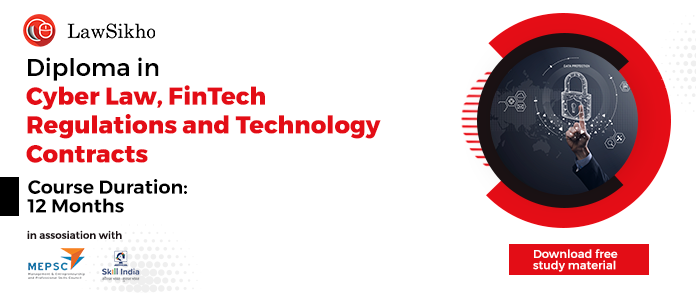This article is written by Parul Chaudhary, pursuing a Certificate Course In Technology Contracts from LawSikho. The article has been edited by Prashant Baviskar (Associate, LawSikho) and Smriti Katiyar (Associate, LawSikho).
Table of Contents
Introduction
The Software license agreement includes user licenses, distribution agreements, assignments, and work-for-hire agreements. In a license agreement, the customer is granted intellectual property rights to enable them to form copies of the software. Since the right to form copies is protected by copyright law, such a license is required for the rights to be transferred to the customer. Customers can get a good array of additional rights, including the right to:
(a) reproduce the software;
(b) modify the software as per customer’s needs;
(c) distribute it;
(d) openly display the software to the public; or
(e) sub-let or further licensing the software, given that such a restriction is present in the license agreement itself.
However, the license may restrict the number of copies or duration of use of the software by the customer.
On the other hand, under a cloud services agreement, a service provider hosts a cloud network or system and the customer is granted access to that system remotely through the internet. The fact that a cloud service agreement is not for a product, like software, but is an agreement to use the cloud network itself, is what makes it different from the software licensing agreement. Cloud services do not involve the making of a replica on the device of the customer so as to use the software as a product, nor does it involve direct human intervention to supply any services to the customer as a service. The idea is to let the customer remotely access the software which is on the server of the vendor. Thus, a cloud services agreement revolves around a subscription-based model, instead of a license. Although the customer only gets access to limited rights under a subscription, they are often an economical alternative, depending upon the requirements of the customer.
Important clauses of a software licensing agreement
- The most important clause in a software license agreement is the obligation upon the licensor to deliver the software to the licensee. The agreement should also contain a clause authorizing the making of copies or replicas of the licensed software, and if such authorization is not granted, then a clause limits the right of the user from making copies of the product.
- In a software license agreement, the right of the licensor to claim payment arises as soon as it delivers the software and grants the license to the user to use the software for the agreed purposes as mentioned in the contract between them, this must be clearly stated
- Another important thing to mention in the agreement is the information that the license is sublicensable or not, and whether it has been granted to the user exclusively or on a non-exclusive basis.
- In case of an exclusive license, the licensor shall not grant the same license to another user for the term of the agreement, and if the license is non-exclusive, the licensor is free to grant the same license to use the same software to other users as well, and this shall not affect the agreement between the licensor and the licensee.
- The clause regarding The clarification as to the fact that the user shall deploy its own hardware and infrastructure in order to use the software and all maintenance costs and manpower is to be borne by the user must be there
- The licensor shall only be responsible to the extent of supplying the software and granting the license to use it for the term of the contract. The data, including but not limited to the software object code, license key and other technical information necessary to run the software, received by the licensee from the licensor while using the software shall remain the exclusive property of the licensor.
- It must have an audit clause to check the performance of the software from time to time.
Important clauses of a cloud services agreement
A cloud services agreement generally comprises of three important segments:
Agreement with the customer
It is imperative to state clearly the roles and responsibilities of each party in the contract. Herein, the customer who seeks a cloud service and the seller who is providing the cloud service must define their rights and liabilities under this agreement, so that no confusion pertaining to the same may arise in the future. The essence of this clause is to grant the right to access the customer so that he may use the cloud platform under a subscription, as per his needs. The nomenclature for the agreement may be different, and a customer agreement may also be referred to as a ‘Master Service Agreement’ or a ‘Terms of Service’, but they essentially entail the same thing.
Acceptable use policy
This section is more restrictive in nature because it lists down explicitly the limits of use that are permitted by the service provider and what lies beyond permissible use. The factors which are listed as improper or illegal use of the service will not be protected under the provisions of the contract as they lie beyond the scope of the acceptable use policy of the service provider. The customers or users using the cloud service must not act beyond the acceptable use policy, otherwise, it may result in a breach or a ground for termination of the contract.
Service level agreement
This section is more technical in nature as it deals with the nuances of the different levels of service which can be described using several attributes including availability, uptime, downtime, performance, backup, or serviceability. The service level agreement clearly states the acceptable limit of these attributes and the monetary compensation which the service provider will have to provide in case of violation of those limits. It bridges the gap between the expectations of a customer and the reality of the service provider by reinstating the business and technical realities that the service levels may have.
Practical usage of both agreements
A software license agreement is generally deployed in cases where the customer wants to use the software, instead of building it from scratch. Therefore, they get a license to use the software as is or make modifications to it as per their wish, given that the contract allows such modifications within the software. However, the hardware installations, power supply for required consumption, and costs are to be borne by the user in order to support the smooth running of the licensed software. Since the space is limited in particular hardware and the software can support a limited number of operations depending upon its type, therefore, an attempt to increase the scale of operations will require the hardware to be compliant with such space requirements, or the change of the hardware setup altogether, which can be an extremely expensive affair. Hence, there is a likelihood that in case the business wishes to expand its operations in the future, there might be some scalability issues with the licensed software. As a result, the company might have to do an overhaul of the hardware or use some other software that has the greater operational capacity to suit the needs of the business.
On the other hand, a cloud services agreement gives the customers the liberty to pick and choose from the available range of services as per their need, budget, and convenience, without having to install separate software to run it. Moreover, the customers only have to pay for the services that they use and do not have to worry about maintenance and upkeep expenses, and unlimited storage space as well. The user also does not have to make copies, unlike in a software license. Therefore, using cloud services is faster, price effective, and provides greater scalability, because the services can be added or reduced as per the consumption requirements of the customer. It gives better protection to data because it is not stored physically on any system, but on the cloud network itself.
Another factor that differentiates the two and makes cloud services a more lucrative option is the fact that the user does not have to buy any special equipment or devices to use the service, as it is cloud-based and can be accessed from any device anywhere. However, software that is specifically developed for a particular business can be licensed in order to not make the software from scratch and use it in that specific business, which is tailored specially to cater to their requirements. That creative freedom is not always present in a cloud service agreement, and the user has to choose from the available options and the cloud service provider does not generally offer to build a specific cloud network for one business. Therefore, in order to cater to the specific needs of a business, the company or the user might prefer to go for a software license agreement, in order to onboard or use custom software that has already been made by someone else, but can be licensed to the user.
Conclusion
The key difference between both these types of technology-centric agreements is that the software license agreement is primarily based upon the license grant, while the cloud services agreement takes a subscription-based approach. The clauses of the agreements will also differ based on the approach of granting the rights to the user. In a software license agreement, the payment clause can be drafted as such so as to be made after the completion of the delivery of the software to the user or after its installation, whereas in a cloud services agreement, the payment is generally made after the service has been provided by the cloud service provider to the user. Moreover, as discussed above, the software license is less scalable in comparison to a cloud service, which in turn affects the costs of both the services, including setup and maintenance expenses. Both agreements are rampantly being used in the IT industry because of their specific uses, and the user has the liberty to decide which agreement to enter into in order to better suit the requirements of his business.
References
- https://www.telos.com/assets/Telos-Software-as-a-Service-Subscription-Agreement-2017.pdf
- https://techcontracts.com/2020/02/20/cloud-services-neither-products-norservices-understanding-saas-contracts/
- https://www.xperience-group.com/blog/cloud-vs-on-premise-software/
- https://www.cleo.com/blog/knowledge-base-on-premise-vs-cloud
- https://www.omg.org/cloud/deliverables/CSCC-Practical-Guide-to-Cloud-Service-Agreements.pdf
- https://blog.ipleaders.in/software-agreement/#:~:text=A%20software%20licensing%20agreement%20is,the%20software%20and%20its%20purchaser.&text=The%20agreement%20acts%20as%20a,the%20use%20of%20the%20software
Students of Lawsikho courses regularly produce writing assignments and work on practical exercises as a part of their coursework and develop themselves in real-life practical skills.
LawSikho has created a telegram group for exchanging legal knowledge, referrals, and various opportunities. You can click on this link and join:https://t.me/joinchat/J_0YrBa4IBSHdpuTfQO_sA
Follow us on Instagram and subscribe to our YouTube channel for more amazing legal content.













